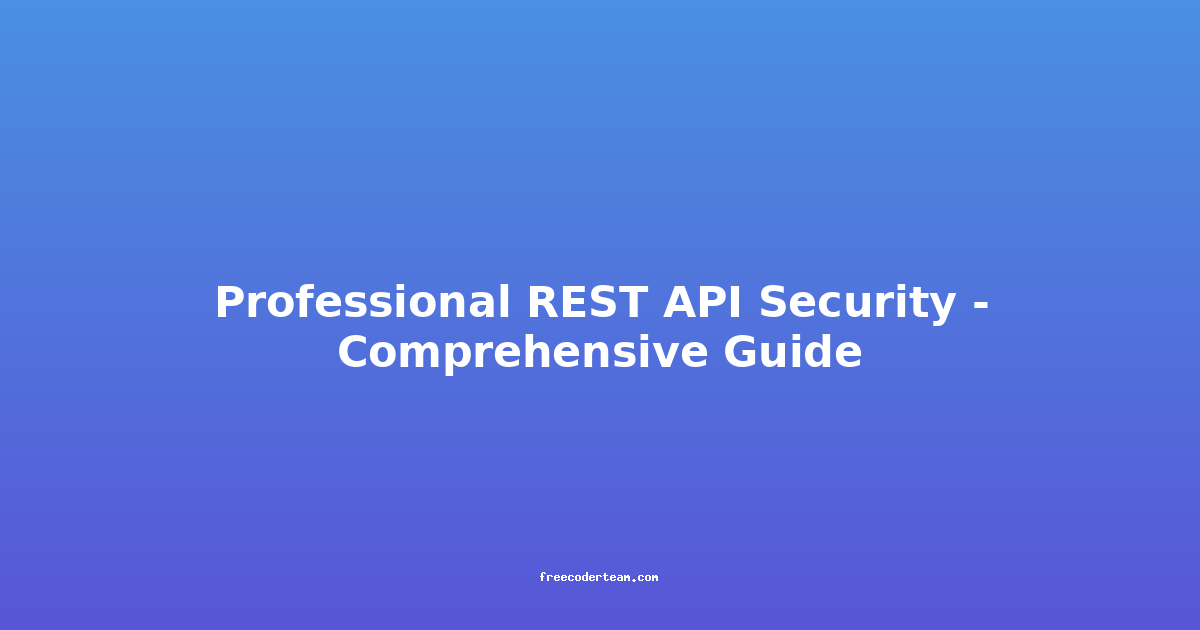Professional REST API Security: A Comprehensive Guide
In today's digital landscape, REST APIs have become the backbone of modern web applications, enabling seamless communication between different services. However, as the reliance on APIs grows, so does the risk of security vulnerabilities. Securing REST APIs is not just a best practice—it's a necessity to protect sensitive data, maintain user trust, and comply with regulatory requirements.
This comprehensive guide will walk you through the essential concepts, best practices, and actionable insights to secure your REST APIs effectively. Whether you're a developer, architect, or security professional, this post will provide the tools and knowledge you need to build robust and secure APIs.
Table of Contents
- Understanding REST APIs
- Common API Security Threats
- Best Practices for Securing REST APIs
- Tools and Frameworks for API Security
- Testing and Monitoring Security
- Conclusion
Understanding REST APIs
REST (Representational State Transfer) is an architectural style for designing networked applications. REST APIs expose data and functionality through a set of HTTP endpoints, making them accessible to clients like web browsers, mobile apps, and other services. While REST APIs are widely adopted, their design often exposes them to security risks if not implemented correctly.
Key Characteristics of REST APIs
- Stateless: Each request from the client to the server must contain all the necessary information. The server does not store session data between requests.
- Client-Server Architecture: Separates the concerns of the client and server, allowing each to evolve independently.
- Uniform Interface: Uses standard HTTP methods (GET, POST, PUT, DELETE) to interact with resources.
- Layered System: Allows intermediaries like proxies or gateways to improve performance, security, or scalability.
Common API Security Threats
Before diving into the best practices, it's crucial to understand the common security threats that REST APIs face:
-
Injection Attacks:
- SQL Injection: Malicious users can inject SQL queries into input fields to manipulate or retrieve sensitive data.
- Command Injection: Similar to SQL injection, but targets server commands rather than databases.
- Cross-Site Scripting (XSS): Injecting malicious scripts into dynamic web content.
-
Broken Authentication:
- Weak or misconfigured authentication mechanisms can lead to unauthorized access.
-
Sensitive Data Exposure:
- Failure to properly encrypt or protect sensitive data, including API keys or user credentials.
-
Cross-Site Request Forgery (CSRF):
- Attackers trick users into submitting requests to a web service they are authenticated with.
-
Insecure Direct Object References (IDOR):
- Accessing resources directly via predictable URLs without proper authorization checks.
-
Insufficient Logging and Monitoring:
- Lack of logging can make it difficult to detect and respond to security incidents.
Best Practices for Securing REST APIs
1. Authentication and Authorization
Authentication verifies the identity of users, while authorization determines what actions they are permitted to perform. Implementing robust authentication and authorization mechanisms is critical.
OAuth 2.0 and OpenID Connect
OAuth 2.0 is a widely adopted standard for authorization. It allows third-party applications to access user resources without exposing passwords. OpenID Connect extends OAuth 2.0 by providing user identity information.
# Example: OAuth 2.0 flow using Python's requests library
import requests
# Obtain an access token
response = requests.post(
'https://example.com/oauth/token',
data={
'grant_type': 'password',
'username': 'user@example.com',
'password': 'securepassword',
'client_id': 'your_client_id',
'client_secret': 'your_client_secret'
}
)
access_token = response.json().get('access_token')
# Use the access token in subsequent requests
headers = {
'Authorization': f'Bearer {access_token}'
}
response = requests.get('https://api.example.com/resource', headers=headers)
JSON Web Tokens (JWT)
JWTs are commonly used for stateless authentication. They are self-contained and signed to ensure integrity.
// Example: Generating a JWT using the jsonwebtoken library in Node.js
const jwt = require('jsonwebtoken');
const token = jwt.sign(
{ userId: 'user123', role: 'admin' },
'your-secret-key',
{ expiresIn: '1h' }
);
Best Practices
- Use HTTPS to encrypt all API traffic.
- Avoid exposing tokens in the URL.
- Use short-lived tokens with proper expiration and refresh mechanisms.
2. Data Encryption
Encrypting data in transit and at rest is essential to protect sensitive information.
HTTPS (TLS/SSL)
Always use HTTPS to encrypt communication between the API and clients. This prevents eavesdropping and man-in-the-middle attacks.
End-to-End Encryption
For sensitive data, consider encrypting it at the application level before transmitting it.
3. Input Validation and Sanitization
Invalid or malicious input can lead to injection attacks. Always validate and sanitize inputs before processing them.
Input Validation
- Type Checking: Ensure inputs match the expected data type (e.g., integers, strings).
- Range Validation: Check if numeric inputs fall within acceptable ranges.
- Format Validation: Use regex or built-in validation libraries to validate formats (e.g., email addresses).
Sanitization
Remove or escape potentially harmful characters from user input.
// Example: Sanitizing user input in Node.js
const userInput = req.body.username;
const sanitizedInput = sanitizeHtml(userInput, {
allowedTags: [],
allowedAttributes: {}
});
4. Rate Limiting
Rate limiting prevents abuse by limiting the number of requests a client can make within a specified time frame.
Implementing Rate Limiting
Use middleware or third-party services to enforce rate limits.
# Example: Rate limiting in Flask using Flask-Limiter
from flask import Flask
from flask_limiter import Limiter
from flask_limiter.util import get_remote_address
app = Flask(__name__)
limiter = Limiter(
app,
key_func=get_remote_address,
default_limits=["200 per day", "50 per hour"]
)
@app.route('/api/resource')
@limiter.limit("10 per minute")
def resource():
return "API resource"
5. API Versioning
Versioning helps manage changes to your API while maintaining backward compatibility. This prevents security vulnerabilities in deprecated endpoints.
# Example: Versioned API routes
GET /api/v1/users
GET /api/v2/users
6. Security Headers
HTTP headers can enhance security by configuring browser behavior. Some important headers include:
- Content Security Policy (CSP): Restricts sources from which the browser can load resources.
- X-Content-Type-Options: Prevents MIME sniffing.
- X-Frame-Options: Protects against clickjacking.
- Strict-Transport-Security (HSTS): Forces HTTPS usage.
# Example: Setting security headers
Content-Security-Policy: default-src 'self'
X-Content-Type-Options: nosniff
X-Frame-Options: DENY
Strict-Transport-Security: max-age=31536000; includeSubDomains
Tools and Frameworks for API Security
Several tools and frameworks simplify the process of securing REST APIs:
-
Swagger (OpenAPI):
- Defines and documents APIs with security specifications.
- Supports OAuth 2.0 and JWT authentication.
-
OAuth 2.0 Frameworks:
- OAuth2-Server (Node.js): Provides OAuth 2.0 implementation.
- django-oauth-toolkit (Python): Integrates OAuth 2.0 with Django.
-
API Gateways:
- AWS API Gateway: Provides built-in security features like IP whitelisting and rate limiting.
- NGINX: Can be configured for advanced security and rate limiting.
-
Security Testing Tools:
- OWASP ZAP: Automated testing tool for identifying vulnerabilities.
- Burp Suite: A popular tool for API security testing.
Testing and Monitoring Security
Regular testing and monitoring are essential to maintaining API security.
-
Penetration Testing:
- Conduct simulated attacks to identify vulnerabilities.
- Use tools like Burp Suite or OWASP ZAP.
-
Logging and Monitoring:
- Implement robust logging to track API requests and responses.
- Use tools like ELK Stack or Splunk for monitoring.
-
API Security Scanners:
- Tools like API Security Scan by Burp Suite can automate security checks.
Conclusion
Securing REST APIs is a multifaceted challenge that requires a combination of robust design, best practices, and continuous monitoring. By implementing strong authentication and authorization mechanisms, encrypting data, validating inputs, and leveraging rate limiting, you can significantly enhance the security of your APIs.
Remember, security is an ongoing process. Stay informed about emerging threats and update your security measures accordingly. With the right tools, frameworks, and practices, you can build APIs that are both functional and secure.
Final Tips
- Always use HTTPS.
- Regularly update dependencies to patch vulnerabilities.
- Train your development team on secure coding practices.
- Perform regular security audits and penetration testing.
By following these guidelines, you can protect your APIs and the sensitive data they handle, ensuring a secure and reliable experience for your users.
Stay secure, stay safe! 🛡️🔒
Feel free to reach out if you have any questions or need further assistance!




